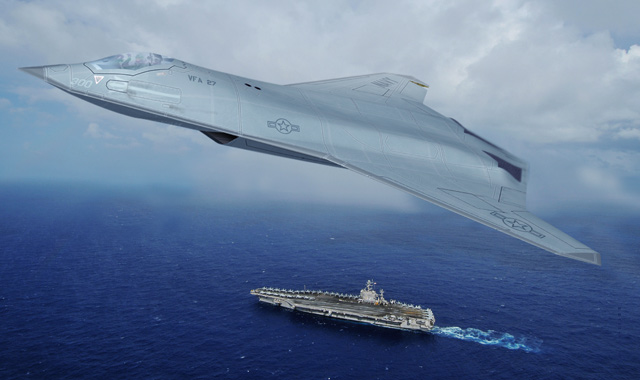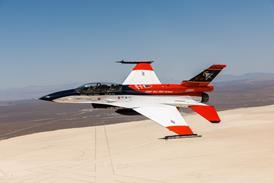Since the arrival of the high-bypass turbofan almost 50 years ago, engineers have made huge strides in jet engine efficiency without altering the basic architecture. Two air flows of constant volume either bypass or enter a core section. The core combusts a mixture of compressed air and fuel to generate thermal energy, which is then converted to supply some of the aircraft’s thrust and most of the power.
For combat aircraft in the mid-2030s, that basic architecture is not going to work, according to the US Air Force Research Laboratory (AFRL). Plans to insert laser weapons into future fighters and armed drones will overwhelm power and thermal management capacity. Ever-growing range and endurance standards require another step change in fuel efficiency for thrust, while advances in ground-based air defences will only increase demand for instant acceleration and nimble manoeuvring.
“In some ways, you’re going to ask the engine to do things they haven’t been asked to do before,” says Chuck Cross, the AFRL’s chief of the Turbine Engine Division.
In the AFRL’s vision, the architecture of the jet engine for military aircraft will change dramatically over the next two decades. Bypass ratios will ebb and flow depending on mission need. Key elements of the compressor will change shape in mid-flight, reshaping the air flow as it is squeezed en route to the combustor. Electrical power could be extracted from low-pressure and high-pressure compressor sections, feeding energy to power-hungry lasers and advanced sensors. The heat created by that power will be stored in newly-created systems, such as electrical accumulators or wax-based heat exchangers.

Future combat aircraft are likely to require highly adaptive powerplants
Northrop Grumman
This re-imagining of the aircraft propulsion system will require a series of innovations extending well beyond the jet engine itself. That is why Cross will appear on 12 September at the Turbine Engine Technology Symposium in Dayton, Ohio, to unveil a new 20-year plan to drive several key advances in jet engine technology.
In a scheduled presentation to the biannual gathering of engine industry officials, Cross will explain the AFRL’s current thinking on the Advanced Turbine Technology for Affordable Mission Capability (ATTAM), the third in a 29-year-old series of engine development umbrella projects.
The first such initiative — Integrated High Performance Turbine Engine Technology (IHPTET) — lasted from 1987 to 2005, yielding a step change in thrust and power performance with the Pratt & Whitney F119 and F135 fighter engines. A second programme — Versatile Affordable Advanced Turbine Engines (VAATE) — sought to deliver another step-change in power, while adding a focus on driving down development and maintenance costs.
The US military’s VAATE-sponsored initiatives are scheduled to continue through 2019, but AFRL has already sketched the broad outlines for the ATTAM programme that will replace it. Reflecting the broad nature and scope of innovations required to achieve goals, ATTAM will be inter-connected with the AFRL’s aircraft based efforts, including projects called Energy Optimised Aircraft and the Megawatt Tactical Aircraft Initiative, Cross says.
Several VAATE initiatives set the stage for further advances that will be pursued under ATTAM. For example, the AFRL has funded GE Aviation and Pratt & Whitney to demonstrate separate prototypes of a jet engine with an adaptable bypass flow. These adaptive engine technology demonstrators (AETDs) will lead to a follow-on competition to develop a final prototype of an engine that can be inserted into the Lockheed Martin F-35A after 2021, allowing that short-ranged fighter a range boost of up to 25%.
Another programme that will transition from the VAATE initiative is a follow-on from the highly efficient embedded turbine engine (HEETE). Originally conceived for mobility aircraft, the advanced compressor developed under the re-named ADAPT programme will feature variable stator vanes inside the compressor, shifting the direction of the airflow as the AETD technology adjusts the amount of bypass flow. Additionally, future engine cores could engage another stage of compression in certain flight modes.
As the engines become more efficient, the materials used inside the core must be adapted to endure hotter temperatures, Cross says. So temperature-resistant metallics and ceramic matrix composites now used behind the combustor could migrate to the last stages of the high-pressure compressor, he says.
For ATTAM, however, the key is to integrate the aircraft’s propulsion system and onboard power systems.
“The big challenge we see in the future is how do I really design and procure systems that take into account all these different variables, and it may not mean buying the best engine - the most optimised cycle. You may sub-optimise one part for the greater system,” Cross says. “As we work closer with the power and energy community, we start to really investigate those give and takes.”
Source: FlightGlobal.com



















